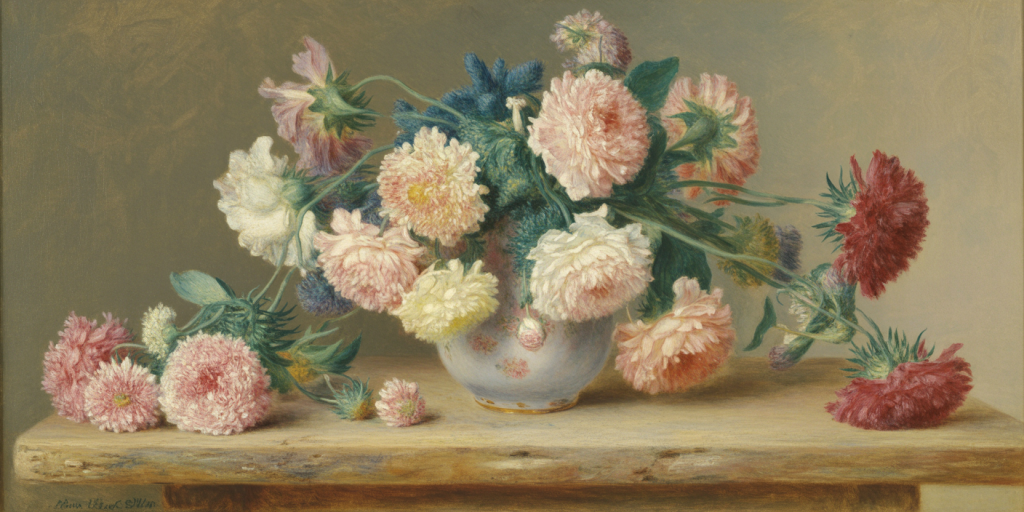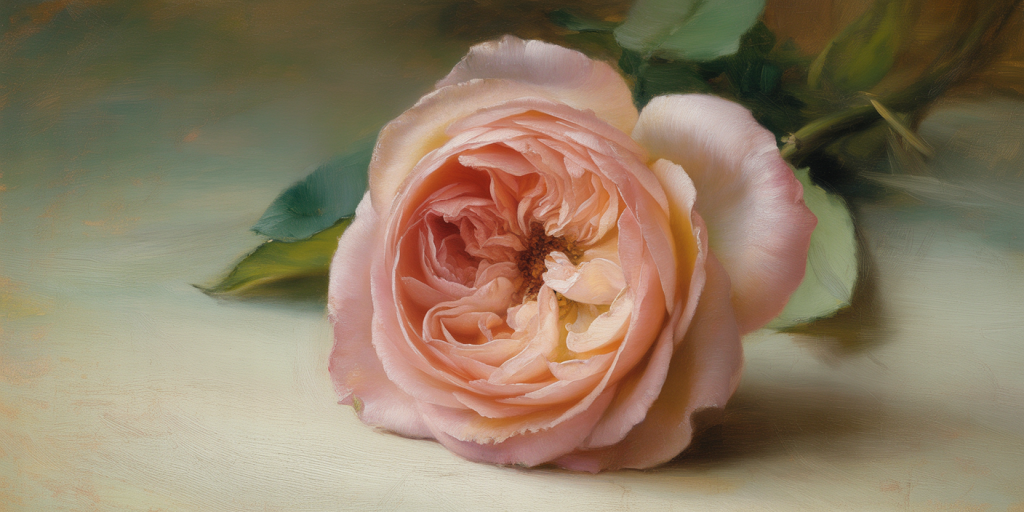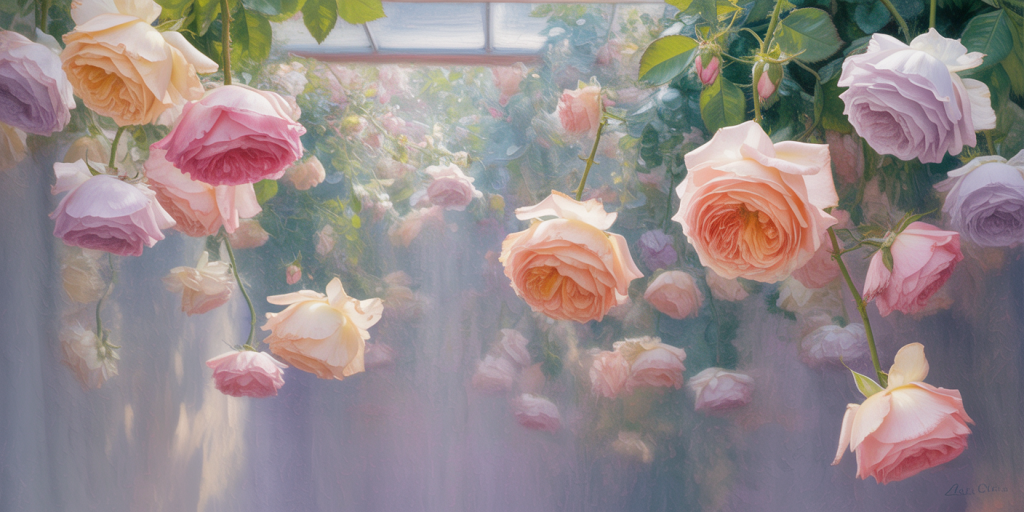The Flowers That Wait in Silent Vases: Renoir in His Moments of Absence
A Contemplative Opening
They do not speak, yet they remain. A cluster of roses, chrysanthemums, or peonies nestled in a vase — neither wild nor arranged with ostentation. These are flowers that do not perform, that do not boast. They simply exist, breathing color into stillness, waiting as if time itself had forgotten to flow. And in that forgetfulness, Pierre-Auguste Renoir painted them — not as subjects, but as presences.
These vases are not merely containers of blooms. They are reliquaries of quiet — soft-spoken guardians of color and light. Renoir, in his silent interludes, found refuge in them. When the clamor of Parisian terraces and sunlit bodies softened into dusk, he turned to the intimacy of the floral. Not to celebrate beauty, but to listen to it.
Table of Contents
- The Light That Rests on Petals
- A Vase as a Heartbeat of Porcelain
- The Gentle Refusal to Bloom Loudly
- Shadows That Do Not Threaten
- The Sigh in a Fold of Velvet Red
- Brushstrokes of Breath
- The Weight of Softness
- Flowers as Memory, Not Ornament
- The Solitude of Bouquets
- Renoir’s Palette of Silence
- The Table as Altar
- Texture that Murmurs in Light
- Petal by Petal: Time Dissolved
- Color Suspended in Hesitation
- The Emptiness Around the Arrangement
- A Gesture of Unspoken Longing
- Blossoms as Tender Resistance
- Domesticity Transformed into Eternity
- The Unnamed, the-Unrushed, the Unfinished
- Still Life as Soul Mirror
The Light That Rests on Petals
In Renoir’s still lifes of flowers, light does not pierce — it lingers. It slides across soft petals like a whisper across skin. The blossoms do not glow from within, but bask in a borrowed warmth. This is not divine illumination, but something gentler — an afternoon sigh.
The light never forces. It caresses. Its source is almost always ambiguous — perhaps a window, perhaps memory itself.
A Vase as a Heartbeat of Porcelain
The vase is not just a pedestal. In Renoir’s hands, it becomes the pulse of the composition. It anchors the blooms with subtle gravity. Often dimpled, patterned, or glazed with reflected hues, the vase breathes with the life of what it holds.
Sometimes ceramic, sometimes glass — it never steals attention. It is the quiet strength beneath the flutter.
The Gentle Refusal to Bloom Loudly
Renoir’s flowers are never flamboyant. They do not erupt; they linger. They tilt toward the viewer like secrets nearly spoken. Their petals curl in repose, often past their peak — a nod to fragility, to temporariness.
There’s no insistence in their color. Even the brightest reds seem weary with softness.

Shadows That Do Not Threaten
The shadows Renoir paints are not declarations — they are invitations. Soft-edged, gray with the hush of lavender, they gather around the vase like companions rather than antagonists.
Their presence doesn’t dim the light; it defines it. They are the dusk to the bloom’s dawn.
The Sigh in a Fold of Velvet Red
When Renoir renders a red rose, it is not fire but velvet. The texture speaks of touch — soft, uncertain, trembling at the edges. The red is never pure. It is flecked with orange, dulled by shadow, kissed by pink.
This is not the red of passion, but of nostalgia — a color with memory in its folds.
Brushstrokes of Breath
The brush does not strive for precision. Renoir allows his marks to dissolve edges, to suggest instead of define. A petal becomes a cloud, a shadow becomes air. It is as though the painting were exhaled rather than painted.
One does not count leaves or species. One feels their presence, like flowers remembered in a dream.
The Weight of Softness
Ironically, it is softness that gives these compositions their weight. The density of overlapping petals, the folds of tone upon tone, create a visual gravity. The flowers seem to sink slightly into the space — not floating, but settling.
They do not hover. They endure.
Flowers as Memory, Not Ornament
These are not flowers placed for decorum. They are memories in bloom. One feels they were brought in absentmindedly, placed on the table as gesture, and left — to wait, to fade, to remain.
They carry intimacy. The hand that picked them is absent, but its warmth lingers.
The Solitude of Bouquets
No other objects intrude. No fruit, no books, no busts. Only the flowers and their silence. They are not in conversation with a world — they are the world.
And in that solitude, we feel Renoir’s. He is not distracted here. He is present. Fully.
Renoir’s Palette of Silence
The colors whisper. Cream, blush, misty lilac. Even yellows, when they appear, seem dipped in butter rather than flame. This is not the vibrant palette of Renoir’s garden parties. It is quieter, deeper, almost private.
These are the colors one sees with eyes half closed.

The Table as Altar
The surface upon which the vase rests is sacred. Not by ornament, but by presence. Renoir’s tabletops are plain, yet carry the gravity of ritual. The flowers sit at their center as offerings — of light, of time, of unspoken thought.
This is not the grand altar of churches. It is the altar of domestic devotion.
Texture that Murmurs in Light
The texture of paint is visible — feathery, layered, soft like moss. Renoir builds his image like one would gather petals: gently, layer by layer. The canvas does not just show — it speaks.
One imagines the feel of these brushstrokes: warm, fragile, human.
Petal by Petal: Time Dissolved
There is no rush in these arrangements. Each bloom seems to exist outside of chronology. Time is not passing — it is held, gently, between the folds of paint and silence.
The flowers do not wilt. They wait.
Color Suspended in Hesitation
Some petals seem hesitant — caught between tones, unsure whether to deepen into shade or lighten toward air. This liminality creates atmosphere. The entire painting trembles with not-yet and almost.
Even color becomes emotional. Even hue becomes hesitation.
The Emptiness Around the Arrangement
What is not painted matters as much as what is. Renoir often leaves the surrounding space bare, blurred, quiet. That negative space holds breath. It cradles the bouquet.
This is absence made visible — not void, but grace.
A Gesture of Unspoken Longing
There’s a longing in these flowers. They lean, they curl, they press against one another as though seeking the hand that once arranged them. But the hand is gone. Only longing remains.
Renoir paints this longing without sorrow — only softness.
Blossoms as Tender Resistance
In their silence, these flowers resist. Not with boldness, but with endurance. They remain, glowing gently, even as the world rushes elsewhere. They are fragile, yet unmoved.
This is resistance as patience. Beauty as defiance through stillness.
Domesticity Transformed into Eternity
What could be more ordinary than flowers in a vase? And yet, Renoir makes them eternal. Not by monumentalizing them, but by listening deeply to their quiet.
He transforms domesticity not into grandeur, but into timelessness. Into hush that outlasts sound.

The Unnamed, the Unrushed, the Unfinished
Renoir rarely names his floral subjects. They are not catalogued. They are felt. This refusal to define allows them to remain fluid — unfixed, alive.
They do not demand conclusion. They do not arrive. They simply are.
Still Life as Soul Mirror
Ultimately, these flower paintings are mirrors. Not of surface, but of sensation. The viewer does not learn something new — they remember something old. A memory of peace. A moment unspoken.
Renoir gives us not still life, but still soul.
FAQ
Did Renoir frequently paint still lifes of flowers?
Yes. Although better known for his figures and social scenes, Renoir returned often to floral still lifes throughout his career, especially during moments of illness or withdrawal.
Why did he paint so many vases of flowers?
The flower still lifes offered Renoir respite and focus. They allowed him to explore color, texture, and emotion without narrative — a space of quiet reflection and experimentation.
What distinguishes Renoir’s floral still lifes from others of his era?
Renoir’s brushwork is looser, his palette gentler, and his approach more emotional than decorative. He paints not flowers as objects, but as moments — fragile, intimate, luminous.
Were these works commercially successful during his lifetime?
While Renoir’s portraits and figure paintings garnered more public attention, his flower paintings were admired by collectors and artists alike for their color sensitivity and poetic tone.
Do any particular flower paintings stand out?
Works like “Roses in a Vase”, “Bouquet de Fleurs” or “Chrysanthemums” represent his approach well — intimate, softly luminous, and emotionally evocative.
Final Notes from the Edge of a Bloom
There is something sacred in Renoir’s floral silence. A reverence that does not shout. A tenderness that does not ache. In a world so often demanding spectacle, these paintings invite us to sit, to wait, to notice.
The flowers do not speak. But in their waiting, in their patient unfurling beneath Renoir’s touch, they teach us how to look — not at things, but through them. They teach us that absence is not emptiness, and that stillness is not death, but devotion.
